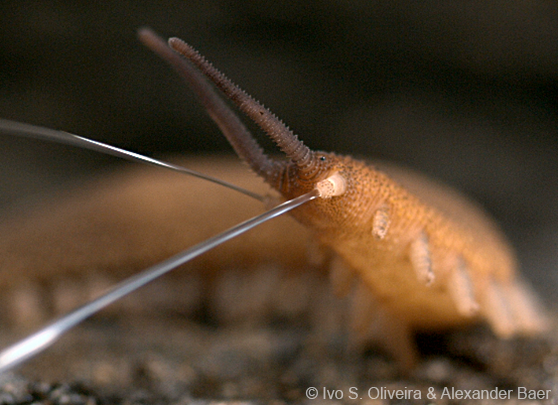
Some characteristics of Onychophora

The scientific name Onychophora means "claw-bearers" (Greek: όνυξ = nail/claw and φέρω = carry/bear) and refers to a pair of sclerotized claws on the tip of each leg [5], while the English name "velvet worms" highlights the velvety appearance of the water-repellent onychophoran body surface [6]. The chitinous cuticle is moulted periodically, mediated by ecdysteroid hormones [7]. Hence, onychophorans are typical ecdysozoans. Within the Ecdysozoa, Onychophora is united with Tardigrada and Arthropoda in the clade Panarthropoda [8], but the exact relationship of these three panarthropod groups is discussed controversially [9].
The overall anatomy of onychophorans has remained largely unchanged in the last 540 million years, as they resemble the Early Cambrian lobopodians, such as ✝Aysheaia pedunculata from the Burgess Shale formation in Canada and ✝Onychodictyon ferox from the Chengjiang fauna of China [10]. The extant onychophorans share with the extinct lobopodians unjointed limbs (=lobopods), a soft body without an exoskeleton, and homonomous segmentation [11]. Due to these ancestral features, onychophorans are an important outgroup for understanding the evolutionary changes that have taken place in the arthropod lineage.
References
2. Baer & Mayer (2012) J. Morphol. 273:1079–1088.
3. Manton & Heatley (1937) Philos. Trans. R. Soc. B Biol. Sci. 227:411–464.
4. Nielsen (2013) Invertebr. Biol. 132:1–13.
5. Oliveira & Mayer (2013) J. Morphol. 274: 1180–1190.
6. Storch & Ruhberg (1993) In: Microsc. Anat. Invertebr. 12:11–56.
7. Hoffmann (1997) Invertebr. Reprod. Dev. 32:27–30.
8. Nielsen (2012) Animal Evolution. Oxford Univ. Press.
9. Mayer & Whitington (2009) Dev. Biol. 335:263–275.
10. Ou et al. (2012) Nat. Commun. 3:1261.
11. Budd (2001) Evol. Dev. 3:332–342.